Improper tagging of the non-essential small capsid protein VP26 impairs nuclear capsid egress of herpes simplex virus
- PMID: 22952920
- PMCID: PMC3432071
- DOI: 10.1371/journal.pone.0044177
Improper tagging of the non-essential small capsid protein VP26 impairs nuclear capsid egress of herpes simplex virus
Abstract
To analyze the subcellular trafficking of herpesvirus capsids, the small capsid protein has been labeled with different fluorescent proteins. Here, we analyzed the infectivity of several HSV1(17(+)) strains in which the N-terminal region of the non-essential small capsid protein VP26 had been tagged at different positions. While some variants replicated with similar kinetics as their parental wild type strain, others were not infectious at all. Improper tagging resulted in the aggregation of VP26 in the nucleus, prevented efficient nuclear egress of viral capsids, and thus virion formation. Correlative fluorescence and electron microscopy showed that these aggregates had sequestered several other viral proteins, but often did not contain viral capsids. The propensity for aggregate formation was influenced by the type of the fluorescent protein domain, the position of the inserted tag, the cell type, and the progression of infection. Among the tags that we have tested, mRFPVP26 had the lowest tendency to induce nuclear aggregates, and showed the least reduction in replication when compared to wild type. Our data suggest that bona fide monomeric fluorescent protein tags have less impact on proper assembly of HSV1 capsids and nuclear capsid egress than tags that tend to dimerize. Small chemical compounds capable of inducing aggregate formation of VP26 may lead to new antiviral drugs against HSV infections.
Conflict of interest statement
Figures
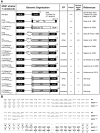

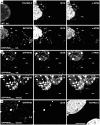

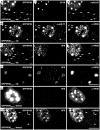
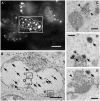
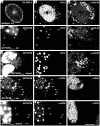
Similar articles
-
Differentiating the Roles of UL16, UL21, and Us3 in the Nuclear Egress of Herpes Simplex Virus Capsids.J Virol. 2020 Jun 16;94(13):e00738-20. doi: 10.1128/JVI.00738-20. Print 2020 Jun 16. J Virol. 2020. PMID: 32321804 Free PMC article.
-
The Product of the Herpes Simplex Virus 2 UL16 Gene Is Critical for the Egress of Capsids from the Nuclei of Infected Cells.J Virol. 2017 Apr 28;91(10):e00350-17. doi: 10.1128/JVI.00350-17. Print 2017 May 15. J Virol. 2017. PMID: 28275195 Free PMC article.
-
Simultaneous Visualization of Parental and Progeny Viruses by a Capsid-Specific HaloTag Labeling Strategy.ACS Nano. 2016 Jan 26;10(1):1147-55. doi: 10.1021/acsnano.5b06438. Epub 2016 Jan 6. ACS Nano. 2016. PMID: 26720596
-
Virus Assembly and Egress of HSV.Adv Exp Med Biol. 2018;1045:23-44. doi: 10.1007/978-981-10-7230-7_2. Adv Exp Med Biol. 2018. PMID: 29896661 Review.
-
Breach of the nuclear lamina during assembly of herpes simplex viruses.Nucleus. 2011 Jul-Aug;2(4):271-6. doi: 10.4161/nucl.2.4.16334. Epub 2011 Jul 1. Nucleus. 2011. PMID: 21941110 Free PMC article. Review.
Cited by
-
Electron microscopy: essentials for viral structure, morphogenesis and rapid diagnosis.Sci China Life Sci. 2013 May;56(5):421-30. doi: 10.1007/s11427-013-4476-2. Epub 2013 May 1. Sci China Life Sci. 2013. PMID: 23633074 Free PMC article. Review.
-
HVint: A Strategy for Identifying Novel Protein-Protein Interactions in Herpes Simplex Virus Type 1.Mol Cell Proteomics. 2016 Sep;15(9):2939-53. doi: 10.1074/mcp.M116.058552. Epub 2016 Jul 6. Mol Cell Proteomics. 2016. PMID: 27384951 Free PMC article.
-
Methods and Applications of Campenot Trichamber Neuronal Cultures for the Study of Neuroinvasive Viruses.Methods Mol Biol. 2022;2431:181-206. doi: 10.1007/978-1-0716-1990-2_9. Methods Mol Biol. 2022. PMID: 35412277 Free PMC article.
-
Correlative Light Electron Microscopy (CLEM) for Tracking and Imaging Viral Protein Associated Structures in Cryo-immobilized Cells.J Vis Exp. 2018 Sep 7;(139):58154. doi: 10.3791/58154. J Vis Exp. 2018. PMID: 30247481 Free PMC article.
-
Superinfection Exclusion of Alphaherpesviruses Interferes with Virion Trafficking.Microbiol Spectr. 2022 Jun 29;10(3):e0068422. doi: 10.1128/spectrum.00684-22. Epub 2022 May 23. Microbiol Spectr. 2022. PMID: 35604159 Free PMC article.
References
Publication types
MeSH terms
Substances
LinkOut - more resources
Full Text Sources

